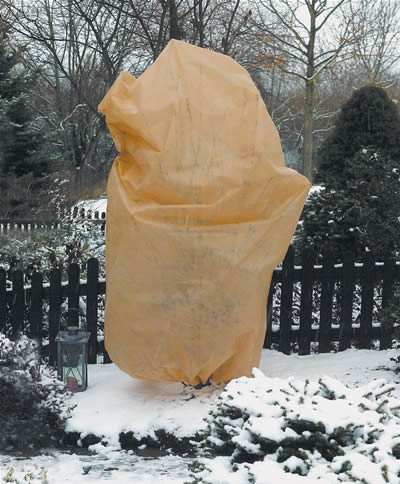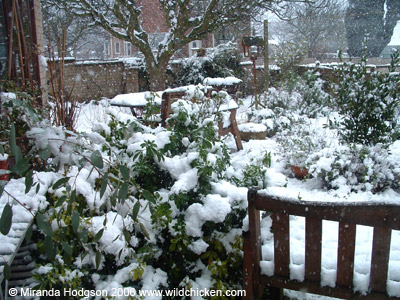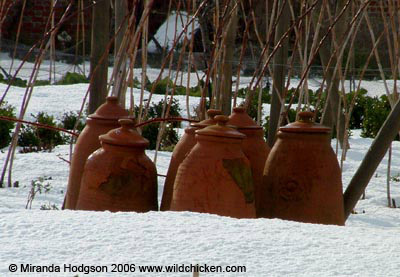Shrub care in winter
includes a list of shrubs that can benefit from winter protection (e.g. horticultural fleece)
With a little care and attention it is possible to successfully over-winter many garden plants which do not grow naturally in the UK climate. The following is a brief guide to caring for your less hardy plants over the cold winter months. At the bottom is a list of plants that may benefit from extra protection using horticultural fleece covers.
Soil
Whether or not the plants in your garden will come through the winter depends to a large extent on the soil you have, as well the plant’s siting. A half hardy shrub planted in sandy soil may do well in a northern garden but not survive the winter on clay soil in the south. This is because the sandy soil is sharper draining, meaning that the roots don’t remain wet for long periods. Improving drainage (by digging in sand and grit) for half hardy shrubs on clay soil can make the difference to keeping a shrub or losing it.
Along with soil, it is important to consider the siting of less hardy shrubs as it isn’t necessarily the frost that does for them, but periods of freezing followed by thawing. What happens is that the frozen sap cells in a leaf expand when they thaw out, which destroys the cells and damages, or even kills, the plant.
Frosts of short duration should cause no damage, but if the temperature looks likely to drop below –3C (27F) for three hours or more then it is advisable to protect less hardy plants. Damage is more likely on yellow-leaved or variegated plants and those which have put out new foliage in autumn or early spring.
The root area
Take care to protect newly planted trees, shrubs and hedges from wind and frost. If the ground freezes, or if there is strong wind, the soil around the base of the plant may move or expand and may need gently re-firming. A thick mulch of bark or straw will protect the root area from cold, while the top can be covered with horticultural fleece.
Horticultural fleece
This is a medium sized horticultural fleece hood - it has a drawstring at the bottom to help keep the frost out.

Some plants will benefit from extra protection from snow and frost.
Snow
A layer of snow can act as a blanket and doesn’t damage plants in the same way that frost can. Although a thick fresh covering of snow looks very pretty in the garden, it can damage plants by its weight, so it’s important not to leave it sitting on plants but to brush it off foliage before the stems become distorted or broken.

Brush thick snow off shrubs to prevent them being damaged by the snow's weight.
Containers
Shrubs in containers will need more protection than those in the ground because they have less root insulation. Lift the containers up onto ‘feet’ to encourage good drainage and wrap the pot itself (in bubblewrap or sacking) to insulate the root area. If you can’t move a container under cover, move it to the best shelter you have, such as against a wall of your house. Extra protection can be afforded by covering with horticultural fleece.
Terracotta containers can be given extra protection from frost and ice by filling the container right to the top with compost. This means that the terracotta is less exposed to freezing and may help to prevent splitting and crumbling.

Rhubarb has long been protected in winter with terracotta 'forcing pots'
Cuttings
For some plants, it’s a good idea to take cuttings just in case. For example, you can do this with the more tender Salvias, like Salvia patens and Salvia discolor.
Plants that may benefit from winter protection - common names follow the botanical names.
-
Abelia schumannii
-
Abutilon vitifolium
-
Abutilon megapotamicum - Trailing abutilon
-
Acacia – wattle
-
Agave americana
-
Aloysia triphylla
-
Azara microphylla - box-leaf azara
-
Callistemon citrinus - crimson bottlebrush
-
Camellias in flower or bud
-
Carpenteria - tree anemone
-
Ceanothus – Californian lilac - especially large-leafed types
-
Cestrum parqui - willow-leaved jessamine
-
Choisya ternata 'Sundance' – Mexican orange blossom
-
Cistus - spotted white rockrose
-
Citrus
-
Clianthus puniceus – lobster claw
-
Convolvulus cneorum – silver bush
-
Cordyline australis – cabbage tree
-
Crinodendron hookerianum – Chili lantern tree
-
Cuphea llavea
-
Daphne bholua
-
Daphne odora
-
Dicksonia antarctica
-
Escallonia
-
Eucryphia x intermedia
-
Ficus
-
Frementodendron – California flannel bush
-
Furcraea longaeva
-
Halimium lasianthum – rock rose
-
Hebe albicans
-
Hebe macrantha
-
Hebe vernicosa
-
Hebe x franciscana 'Variegata'
-
Helichrysum petiolare
-
Helichrysum splendidum
-
Hibiscus
-
Itea ilicifolia
-
Lantana camara
-
Lavandula dentata
-
Lavatera x clementii
-
Leptospermum rupestre - prostrate tea tree
-
Leptospermum scoparium - tea tree
-
Magnolias in flower or bud
-
Mahonia lomariifolia
-
Melianthus major
-
Musa lasiocarpa – Chinese yellow banana
-
Myrtus - myrtle
-
Nandina domestica – heavenly bamboo
-
Olearia - Daisy bush
-
Passiflora – passion flower
-
Phlomis chrysophylla - golden-leaved Jerusalem sage
-
Phlomis lanata - woolly Jerusalem sage
-
Phormium 'Yellow Wave' – New Zealand flax
-
Phygelius - Cape fuchsia
-
Pieris japonica - Lily of the valley bush
-
Pittosporum - Kohuhu
-
Plectranthus saccatus - Spur Flower
-
Punica granatum var. nana - dwarf pomegranate
-
Rosmarinus officinalis Prostratus Group
-
Salvia fulgens - Mexican scarlet sage
-
Santolina chamaecyparissus – cotton lavender
-
Sollya heterophylla - Bluebell Creeper
-
Spartium junceum – Spanish broom
-
Vaccinium glaucoalbum - grey-white blueberry
-
Vinca difformis – intermediate periwinkle
-
Yucca aloifolia
-
Yucca gloriosa
-
Yucca whipplei